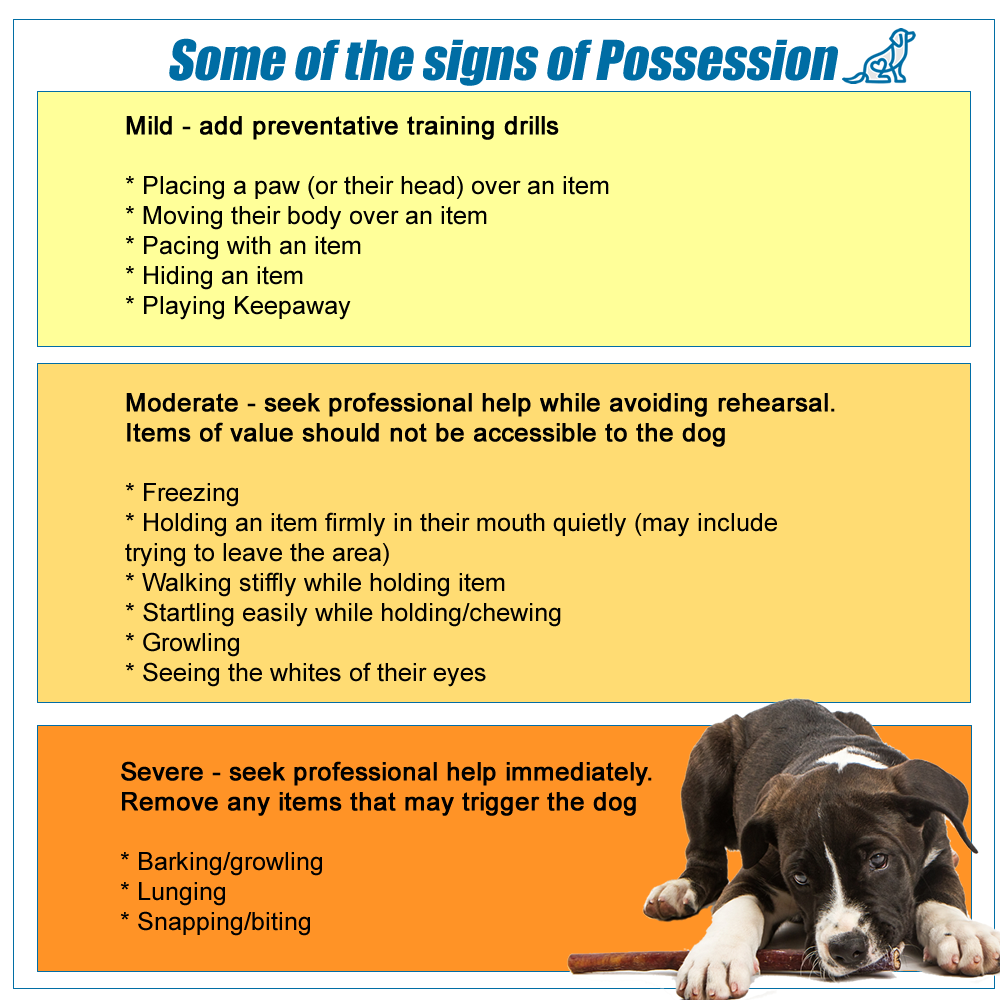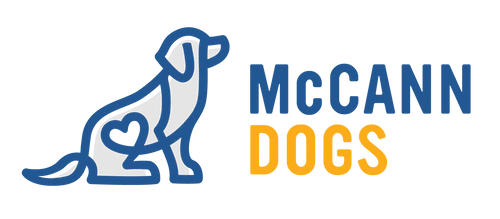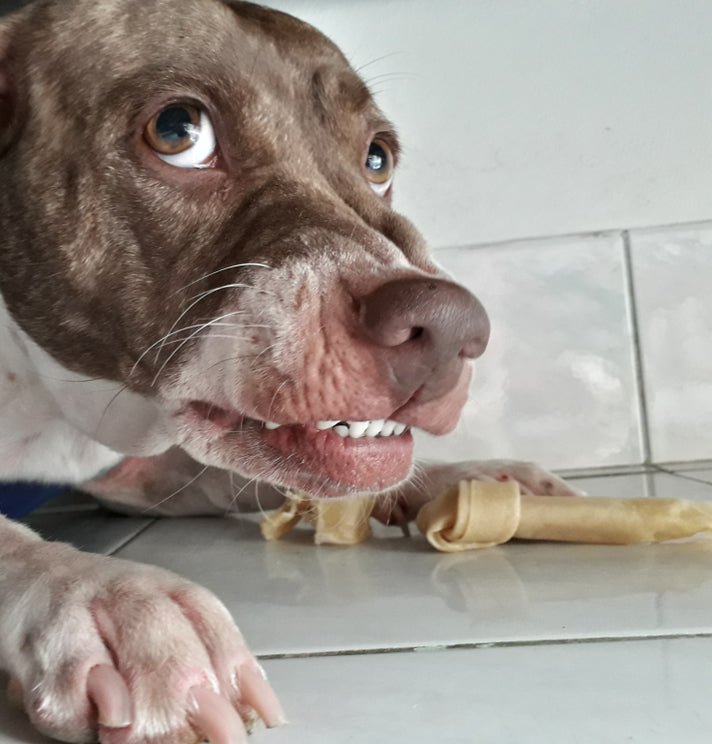Is your pup SWEET as pie when they have a special, valued item? GOOD! Keep reading....
This article is STILL for you!!!
It truly seems like things come in themes in dogdom. I think this is a combination of the ever-evolving role of dogs in our lives and the awareness that society dedicates to a specific theme or problem.
One theme that seems to be common at the moment is dogs showing specifically targeted possession or 'resource guarding' of valuable items. Things like real bones, bully sticks, rawhides (please note that we don't recommend rawhide due to the inherent dangers associated with it) are very valuable items to most dogs. When introduced properly, they can be a wonderful treat for your dog without being dangerous.

First, I think it's important that we recognize the nature of the dog so we don't take any issues that might come up personally. It's not personal, it's nature! All dogs are capable of showing possession. It's hard-wired into them. Imagine the dog who sat back politely at feeding time in a group of dogs. That dog likely wouldn't get to eat.
In modern dogdom, our 4-legged family members are well fed and they don't typically have to fight for their meals and resources, but their instincts are still intact. You might catch a glimpse of instinctual behaviour if you live in a multi-dog household. Or maybe you've had experience with resource guarding. It's crucial to work with a qualified professional if you see any sort of freezing, growling, lunging, barking, biting, etc. from your dog when they have a valued item. Seek professional help as soon as possible. Do not let it fester. The more it is rehearsed, the more dangerous it will become.
Today, we'll talk about prevention and some of the great and easy ways you can work proactively to change your dog's natural emotional response to one that has them HAPPY to see you when they have an item of value.
I know what you're thinking right now..... "I got lucky! My pup is a sweetheart and doesn't blink an eye when I take their chew."
KEEP READING!!! This article is still for you.
These tips are about prevention. We have progressional exercises in our programs that build on these concepts from week to week. We often get asked by our students if they still need to dedicate time to these exercises when they don't have any issues. The answer is a resounding YES!!! Yes, yes, YES!!! These are preventative measures to ensure you won't develop a problem. Simply hoping for the best might be a direct path to a disaster.
***Please note that these tips should not be attempted with a dog who is displaying resource guarding tendencies already without a trained professional present.
So You Just Got a Puppy, Now What?
We start with that fuzzy and uncoordinated puppy you just brought home. At 7 weeks, a dog's brain is pretty close to being fully developed. That means the instinct to guard an item of value may be present in your pup on day 1. It's also possible that your new pup just spent a few weeks rehearsing this tendency with their littermates. There's a lot to be learned in the few weeks before leaving for their new lives. Not all of those learnings will be helpful when moving into a human world. It's 100% acceptable to guard a resource in the rules of the canine world. Move into the human world and it is a total contrast.
Now is the time to work on preventative drills to help your pup succeed where the rules have changed on them. Help them!
What To Do First with those High-Value Items
We fall in love with our new pups so quickly and want them to live their BEST lives, so we look for things that will bring them pleasure. This often leads new puppy owners to the valuable chews that we think our dogs will just LOVE. And they do! But a balance is crucial and sending them off with a bully stick to chew might set you up for a fall.
Think about the order of things. It's important to put communication tools in place when we set out to teach our dogs anything. Our method of training works because our goal is always to set our dogs up to succeed rather than fail. Yes, they make mistakes and we deal with those. Life happens, but our goal when teaching anything is for the dog and handler team to find success.
When I have a new pup home, I will use less valuable chews for them to chew independently. Chews like Nylabones and Kongs are things that they can hang out to chew on their dog bed or in their crate.
During this time, I do use bully sticks and more valuable items, but I maintain control of them. Ie. I possess the valuable item and allow my pup access to it. Typically, this looks like a nice snuggle session with the benefit of a great chew for the pup. This helps in several ways.
- It gives me a chance to help my pup rehearse calm as they are occupied while I hold them.
- It teaches my pup that I bring value to them
- It doesn't give the pup a chance to 'own' the item and therefore very little chance of them guarding the item
I will rehearse this for as long as it takes to build a reliable out. On average, I would say this is the first 2 weeks home.
Next Steps
My next step, which typically happens once the pup is too big to comfortably be in my lap, is to give the item to my pup rather than holding it. This comes with a clear set of criteria for the handler and dog team.
First, if I see anything that makes me uncomfortable, I will abort the mission and re-assess the situation to prevent unwanted rehearsal.
The pup is on leash or house line so I have a means of taking control if necessary. This also allows me to prevent my pup from leaving. I want to continue the idea that I bring GOOD things and that my presence is not a threat at all. So, we continue to hang out with the higher value item and while my pup is chewing, I will occasionally give them a high-value treat. So, they're chewing happily and a hunk of cheese is added - what a nice surprise.
Imagine this win-win scenario for a second. You're eating pie.... mmmmm pie... and really enjoying it.
What could be better?
What if someone came along to dump a scoop of your favourite ice cream on top of your delicious pie?
Life just got better, didn't it?! You didn't even have to give up your pie to get the ice cream. When you see that same person approach the next time, do you think you'll be happy to see them? Of course! They bring value to you and your pie - they're not showing up to take it away.
This is what we want our dogs to feel. That win-win feeling allows them to feel safe when you approach.
What About Skills?
From day 1 home you should be teaching your pup skills that will continue to build on success. I will use the game of tug and trades with lower value items to teach my pup to "out" on command and to "leave it" on command. Lower value items allow these skills to be taught without having to worry about any feelings of anxiety your pup might have about more valuable items. We start to teach this with a trade system and build it quickly to the point of reliability.
The longer you spend trying to pry things out of your pup's mouth, the more you give them the chance to rehearse possessing. They'll clamp tighter to hold onto the thing they've found with each rehearsal. Essentially, they are learning to be possessive if you approaching when they have the special thing means they're going to have to fight to keep it. The twig, leaf, rock, piece of fluff... you get it! All of the things our pups put in their mouths all day long.
Once they learn a solid out command, you have a communication tool to use that they'll understand and you can continue to build value for relinquishing items to you!
Blending the Concepts
Now, we can start to work on the out command with our higher value items since our dogs understand:
1 - the skill of dropping an item on command
2 - you bring value
3 - you're not a threat
As I hang out with my pup close by chewing, I will ask them to 'out' and without taking the valuable item, I will feed them something high value. They then get the "okay" to have another chew.
Building on this progression over time might look like this:
- say out, then feed, then permit to chew
- say out, then feed, then touch the stick, then feed, then permit them to chew
- say out, then touch the stick, then feed, then permit them to chew
- say out, then pick up the stick, then feed, give the chew back to your dog
The next steps would be to start working on adding an approach while bringing value. The best dog training is broken down into steps and stages that allow for success, both immediately and in the long term.
Frequency
This will differ with each dog as they all have different levels of tolerance. I practise these types of things throughout my dog's entire life to ensure bad habits never creep in.
I've had pups who eagerly play along with every repetition and I've had those who start to get anxious with too many repetitions. With the experience I have to date, I tend to stick to 5 reps per training session to prevent overdoing it.
Finally, Some Things to Avoid
There is a lot of bad or outdated advice in dog training, so this would not be a complete article if it didn't contain a warning about some of the common mistakes to avoid that often create an issue rather than helping with one.
The, "I'm In Charge, so I can Take What I Want" Attitude
Your dog might disagree with you on this.
Thinking that you should be able to take things away from your dog 'just because' is a very slippery slope that might lead you to heartache. We love dogs as dogs. That means they come with instincts that govern them intact and ready for life. We don't get to pick the pieces we like and discard the pieces that are inconvenient for us. We have to look objectively at the pieces that don't fit a human world and find a way to help the dog agree with our point of view.
Some dogs have a very high threshold for guarding and you may get away with never coaching that dog and never experiencing a problem, however that is a crapshoot. There are a lot of dogs who will develop resentment and frustration with this approach over time or immediately and that might spell disaster.
Rather than relying on getting lucky, take some time with preventative measures to get a much better guarantee.
Hovering
We talked about hanging out with your pup while they chew. Hovering is different and might create feelings of frustration or anxiety that will lead to resource guarding. If you're working on the approach to add value, be sure you move in smoothly and offer the value, then retreat. Simply standing over them as they eat their meals or reaching in to touch or pet them as they chew will put some dogs off and create an issue.
Work with purpose!
Always remember that the best advice for possession is preventative, and the best result from this advice is the possession you never see!
Until next time,
Happy Training!

